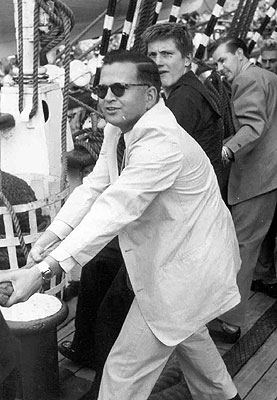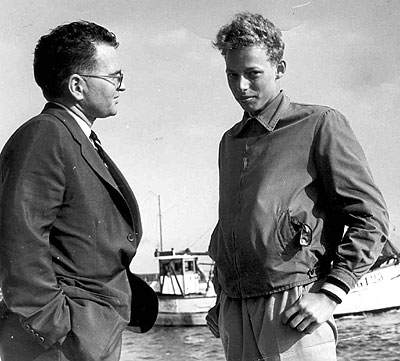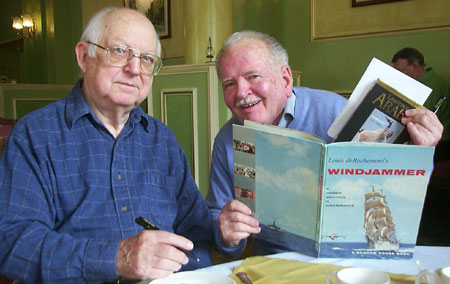The Danes And The Windjammers |
Read more
at in70mm.com The 70mm Newsletter |
| Written by: Borden Mace | Date: March 18, 2004 |
 Borden Mace (above) on board a Windjammer.
Hauerslev collection. Borden Mace (above) on board a Windjammer.
Hauerslev collection.Once Louis de Rochemont Associates and the RD-DR (Readers Digest – De Rochemont) Corporation decided to make "Windjammer" for National Theatres, I flew to St. Thomas in the U.S. Virgin Islands, to have lunch with Captain Knut Hansen, skipper of the “S/S Danmark”. We dined alone, except for two young mess boys who provided excellent service, on the ship's aftermost deck under canvas protecting us from a broiling sun as we calmly rested at anchor in the magnificent St. Thomas harbour. I tried to convince him to sail the Danmark, to be “star” of our scheduled second wide screen spectacular following “Cinerama Holiday”, to the New World (as the Norwegian Christian Radich did eventually) but his schedule, and that of the ship, were set for years in advance. After that rejection, I sent a case of Scotland's best to Captain Hansen with a short note expressing my hope that we would work together in some way in the near future. Captain Hansen was a good friend of the USA, the prestigious duPont family and President Franklin D. Roosevelt, for whom he had trained Americans to sail the "U.S. Eagle", America's only official tall sailing ship (but not a square rigger), during World War II. He remained a friend and advisor throughout the filming of "Windjammer". I next visited Captain Hansen about a year later in Copenhagen while the "Christian Radich" was concluding filming in Boston and getting ready for the long sail back to Europe. I arranged for him and the "Danmark" to participate in a planned tall ships race from Skagen, on the northern tip of Denmark, to Oslo as the final triumphant scene in “Windjammer”. |
Further
in 70mm reading: Louis de Rochemont The Big and the Little Image Cinerama Afterglow "Windjammer" - Exclusive Danish Re-release Internet link: |
 Left: Borden and the prince of Denmark.
Hauerslev collection. Left: Borden and the prince of Denmark.
Hauerslev collection.One day, Ingolf, the young prince of Denmark paid me a visit--arriving by motorcycle--and spent an hour with me while I was visiting on the “Danmark”. For the race the Captain had graciously given me a small but private stateroom, which was very comfortable indeed. I had arranged to sail on the "Danmark" during the race, with--I believe--the former skipper of the “S/S Copenhagen”, a five-mast sailing ship that sank just after he had completed his last voyage and was no longer in charge. That skipper, I seem to remember, sailed with Captain Hansen and me with one other guest, the chairman of the board of directors of the number one brewery in Denmark (Carlsberg or Tuborg) on the successful race to Oslo - crossing the starting line in Skagen within seconds after the cannon fired and arriving in Oslo four or five ship's lengths ahead of the second-place ship, another Norwegian tall sailing ship but not a square rigger like the “ Christian Radich” or the “ Danmark”. Everything about the “ Danmark” was top notch. Everything was clean and orderly. The seamanship from the captain to the newest cadet was extraordinary. While my heart was still with the “Christain Radich” I was falling in love with the “Danmark”. But the “Christian Radich” was the star of our film and on paper it was supposed to win. As reported earlier, we had tried without success to get the "Danmark" to be the featured attraction in our film about how the sea makes men out of boys. Now, the whole story behind the scene can be told. Louis de Rochemont loved to deal with crises; some say he even enjoyed creating them. In any event after my failure to secure the services of the “Danmark,” he went into full action calling all of his many personal friends and contacts in Norway, starting with Alf Bjercke. Louis promised the moon in publicity for Norway and its men of the sea. And his love of the country was genuine and he meant to enhance its already established reputation. He secured the square rigged beauty, the “S/S Christian Radich” with a grand old sea dog, Captain Yngar Kjelstrup, an experienced supporting staff, and 80 new young cadets to make the journey to the New World roughly following the same route as Christopher Columbus. Even the soon-to-become King Olav V was piped aboard the “Christian Radich” with full honors in December 1956 as it prepared to set sail. The King turned over a thousand year old Viking sword, later to be presented on the U.S. Capitol steps to President Eisenhour, however, on permanent loan to the people of the United States. De Rochemont had long loved and admired the people of Norway and shared their love of the sea. He had great respect for Norway’s role in World War II. He hated fascism and all forms of totalitarianism. As far back as January 1938 he had produced for The March Of Time “Inside Nazi Germany”, warning audiences of the lurking danger. Germany was outraged by his films, particularly his first feature “The Ramparts We Watch” (1940) which dramatically showed the similarities between the totalitarian ambitions of Kaiser’s Germany in 1914 and Hitler’s in 1939. It ended with the use of a Nazi propaganda film, “Feldzug in Polen”, a bloodcurdling account of the successful invasion and conquest of Poland in September 1938. The Nazi film spoke for itself and it was frightening. When in 1940 the Pennsylvania State Board of Censors banned the showing of “The Ramparts We Watch” - “for fear of the terrifying effect upon the masses”, Louis personally but unsuccessfully fought the edict during a two hour debate. He claimed the American people were not afraid. “The thing you are doing is promoting appeasement – surrendering to fear – the most dangerous thing facing America today.” The New York Times of September 20, 1940 said, “A more provocative or challenging motion picture has not been placed before the public in years – or maybe, on second thought, never. For the fact of the matter is that there has never been a motion picture just like this one…. By a brilliant conception of Louis de Rochemont, producer of the film, non-actors were used to play the numerous roles of the townsfolk (New London, CT.) thus imparting the illusion of photographed actuality. Through this device, the old newsreels and the fictionalized story blend perfectly. |
|
|
Edgar Anstey wrote in the British weekly Spectator on April 11, 1941: “…the film is so skilfully constructed that it is often hard to tell where news-reel and acted scenes begin…a fit climax to Louis deRochemont’s years of experiment in the reconstruction of modern history for the screen, and it will have more influence on the development of cinema than any other film of recent years. (For film history buffs one of the later great examples of this technique is Gillo Pontecorvo’s
“The Battle of Algiers”, (1966) made with 138 non-actors and only one professional. The illusion of reality was equally impressive. Of course Orsen Welles, an early March Of Time radio actor, had brilliantly recreated a March Of Time opening for his unforgettable
“Citizen Kane”.) On August 17, 1940, all American films were excluded henceforth from release in Nazi Germany and in all countries then occupied by German troops – France, Belgium, Denmark, Norway, Luxembourg and Poland. De Rochemont continued his wake up call for America with such March Of Time subjects as “War, Peace, and Propaganda” (June 1939), “Soldiers With Wings” (Sept 1939), “Battle Fleets of England” (Sept 1939), ”The Republic of Finland” (Jan 1940), “Britain’s R.A.F.” (Oct 1940), “Uncle Sam-The Non-Belligerent” (Jan1940), ”Crisis in the Atlantic” (May 1941, “Peace- by Adolf Hitler” (Aug 1941) and especially “Norway In Revolt” (Sept 1941). Louis deRochemont had recruited some young Norwegians studying at MIT in Massachusetts for some of his recreations including Alf Bjercke (Now a Norwegian paint magnate) who became a life long close friend. And, of course, Louis deRochemont III (Young Louis), one of the directors of “Windjammer”, later moved to Norway, married a beautiful Norwegian girl, and eventually died and was buried in Norway. Enough background and analysis, back to my narrative on the final days of shooting the “Windjammer” with a race from Denmark to Norway. Alf Bjercke had joined me in Copenhagen, where I purchased the biggest Silver Cup I could find, to be presented to the winning ship in Oslo Harbor. Alf and I drove from Copenhagen to Skagen where, at our request, correspondents from across Europe had assembled to cover the start of the race. The only problem: the "Christian Radich" did not show up. We had the "Danmark", another Norwegian ship and maybe a Russian square rigger, set to start the Tall Ships Race of 1957 - but no "Christian Radich". After two days, the news editors began to summon their reporters home. The race was in jeopardy; what to do? At this point we became a secret operation, never revealed until now. I pleaded with Alf Bjercke until he contacted Norwegian officers at home, who sent a destroyer to pick up the becalmed "Christian Radich" off of Scotland, to tow her “in disgrace” to Denmark under cover of darkness. The Norwegian destroyer “deposited” her tow in the harbor at Skagen around 2 A.M., long before sunrise and returned safely to Norway. The “Christian Radich” had dropped anchor but its crew was in no shape or mood for a race early the next morning. After so many days and months at sea two or three hearty souls even escaped to shore for a few beers to celebrate the return to Scandinavia. Only a couple of people in Oslo, the crews of the Radich and a certain destroyer left nameless, know what happened. But after the passage of almost fifty years I have decided to tell the whole story as I recall it. In stark contrast to the still anchored “Christian Radich”, the "Danmark" crossed the starting line seconds after the first cannon shot was fired to signal the start of the "official race.” Immediately thereafter, delicious Martinis (American style) were served to all of the dignitaries assembled on the “Danmark’s” poop deck - the Danish flag aflutter as we sailed proudly into the wind. Our drinks were carefully placed on heavily starched white linen napkins, covering a silver tray. The young sailor bearing our gifts balanced the tray with such precision that not a single drop of our libations was spilled. Such good taste. Such elegance. All that combined with the talent and experience of the Danish team. The outcome of the race was never in doubt. The "Christian Radich" was over two hours late in starting and came in last at Oslo. We had to devise a new ending since "our ship" didn't win. |
|
 Borden
Mace (right) and Dick Babish visited Bradford in 2002. Picture by Thomas
Hauerslev Borden
Mace (right) and Dick Babish visited Bradford in 2002. Picture by Thomas
Hauerslev For an ending to his film even Louis de Rochemont could not apply the British example of “Our best moments are where we lose nobly, such as in ‘The Charge Of The Light Brigade’”. He settled on "Winning is not everything – it’s how you play the game." As a distraction from the loss of the race he also came up with the radio broadcast about the sinking of the German sailing ship, "Pamir". In Buenos Aires I had purchased still photographic shots of the "Christian Radich" made by "Pamir" sailors when they met our ship on their last voyage in the mid Atlantic before its tragic sinking in the same Atlantic Ocean during Hurricane Carrie on September 21, 1957 - on its return, while carrying wheat from Argentina, back to Hamburg, its home port. Out of a crew of eighty-six men and boys, only six were saved. News of that loss of life to the sea picked up via short wave radio by the “Christian Radich” tragically brought the focus of the film back to our theme of "sailing and living and learning at sea makes men of boys". Denmark, the "S/S Danmark" and Captain Hansen were vital parts in the making of "Windjammer". Now, at last, their roles in the final chapter have been revealed. However, Norwegians and all of us involved in the making of “Windjammer” prefer to remember the ending of the picture with the magnificent banquet held by the Mayor of Oslo on the dock in front of City Hall where the “Christian Radich” glistened in brilliant sunshine. “The Pride of Norway” and Louis deRochemont’s “Queen of the Seas” with its gallant crew were safely at home after one great adventure. |
|
|
Go: back
- top - back issues
- news index Updated 22-01-25 |
|
